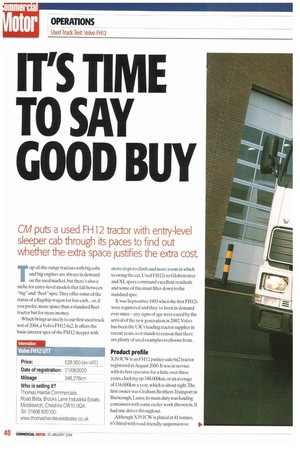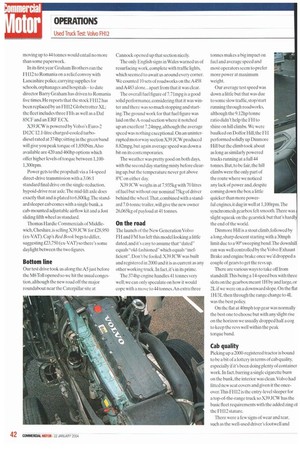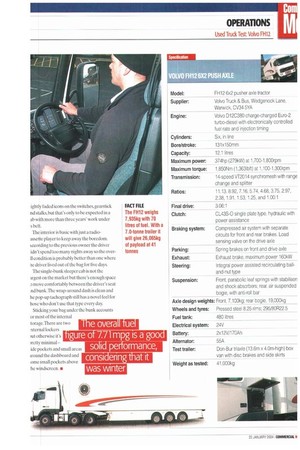I'S UNE TO SAY GOOD BUY
Page 40

Page 42

Page 43

If you've noticed an error in this article please click here to report it so we can fix it.
CM puts a used FH 12 tractor with entry-level sleeper cab through its paces to find out
whether the extra space justifies the extra cost Top-of-the-range tractors with big cabs and big engines are always in demand on the used market, but there's also a niche for entry-level models that fall between "big" and "fleet" spec.They offer some of the status of a flagship wagon for less cash.., or, if you prefer. more space than a standard fleet tractor but for more money.
Which brings us nicely to our first used truck test of 2004, a Volvo FH12 6x2. it offers the basic interior spec of the FM12 sleeper with more steps to climb and more room in which to swing the cat. Used FH12s to Globetrotter and XL specs command excellent residuals and some of this must filter down to the standard spec.
It was September 1993 when the first FH12s were registered and they've been in demand ever since — any signs of age were cured by the arrival of the new generation in 2002. Volvo has been the UK's leading tractor supplier in recent years. so it stands to reason that there are plenty of used examples to choose from.
Product profile X39 JCW is an FH12 pusher-axle 6x2 tractor registered in August 2000. it was in service with its first operator for a little over three years. clocking up 348,000kmor an average of 116.000km a year, which is about right.The first owner was Graham B rothers Transport in Burscough, Lanes; its main duty was hauling containers with some reefer work thrown in. It had one driver throughout.
Although X39 JCW is plated at 41 tonnes, it's fitted with road-friendly suspension so moving up to 44 tonnes would entail no more than some paperwork.
In its first year Graham Brothers ran the F1-112 to Romania on a relief convoy with Lancashire police. carrying supplies for schools, orphanages and hospitals— to date director Barry Graham has driven to Romania live times. He reports that the stock FE12 has been replaced by an F1-112 Globetrotter XL: the fleet includes three FHs as well as a Daf 85CFand an ERF ECX.
X39 JCW is powered by Volvo's Euro-2 D12C 12.1-litre charged-cooled turbodiesel rated at 374hp:sitting in the green band will give you peak torque of 1,850Nm, Also available are 420 and 460hp options which offer higher levels of torque between 1,1001,30Orpm.
Power gets to the propshaft via a 14-speed direct-drive transmission with a 3.06:1 standard final drive on the single-reduction, hypoid-drive rear axle.The mid-lift axle does exactly that and is plated to 6,800kg.The standard sleeper cab comes with a single bunk, a cab-mounted adjustable airflow kit and a Jost sliding fifth wheel as standard.
Thomas Hardie Commercials of Middlewich, Cheshire.is selling X39 JCW for £28,950 (ex-VAT).Cap's Red Book begs to differ, suggesting £23,750 (ex-VAT) so there's some daylight between the two figures.
Bottom line
Our test drive took us along the A5 just before the M6 Toll opened so we hit the usual congestion. although the new road off the major roundabout near the Caterpillar site at Cannock opened up that section nicely.
The only English signs in Wales warned us of resurfacing work, complete with traffic lights, which seemed to await us around every corner. We counted 10 sets of roadworks on the A458 and A483 alone.., apart from that it was clear.
The overall fuel figure of 7.71mpg is a good solid performance, considering that it was winter and there was so much stopping and starting.The ground work for that fuel figure was laid on the A-road section where it notched up an excellent 7.24mpg,although the average speed was nothing exceptional. On an uninterrupted motorway section X39 JCW produced 8.82mpg, but again average speed was down a bit on its contemporaries.
The weather was pretty good on bath days, with the second day starting misty before clearing up,but the temperature never got above 8°C on either day.
X39 JCW weighs in at 7.935kg with 70 litres of fuel but without our nominal 75kg of driver behind the wheel.That , combined with a standard 7.0-tonne trailer, will give the new owner 26,065kg of payload at 41 tonnes.
On the road
The launch of the New Generation Volvo FH and FM has left this model looking a little dated, and it's easy to assume that "dated" equals "old-fashioned" which equals "inefficient". Don't be fooled. X39 JCW was built and registered in 2000 and it is as current as any other working truck. 111 fact, it's in its prime.
The 374hp engine handles 41 tonnes very well;we can only speculate on how it would cope with a move to 44 tonnes. An extra three tonnes makes a big impact on fuel and average speed and most operators seem to prefer more power at maximum weight.
Our average test speed was down a little but that was due to some slow traffic, stop/start running through roadworks, although the 9.12hp/tonne ratio didn't help the FH to shine on hill climbs. We were baulked on Dolfor Hill; the FH performed solidly up Dinmore Hill but the climb took about as long as similarly powered trucks running at a full 44 tonnes. But, to be fair, the hill climbs were the only part of the route where we noticed any lack of power and,despite coming down the box a little quicker than more powerful engines, it dug in well at 1,10Orprn.The synchromesh gearbox felt smooth. There was slight squeak on the gearstick but that's hard the end of the world.
Dinmore Hill is a stout climb, followed by a long, sharp descent starting with a 30mph limit due to a 900 sweeping bend.The downhill run was well controlled by the Volvo Exhaust Brake and engine brake once we'd dropped a couple of gears to get the revs up.
There are various ways to take off from standstill.This being a 14-speed box with three slots on the gearbox meant 1H by and large. or 2L if we were on a downward slope. Onthe flat 1H/3L then through the range change to 4L was the best policy.
On the flat at 40mph top gear was normally the best one to choose but with any slight rise on the horizon we usually dropped half a cog to keep the revs well within the peak torque band.
Cab quality
Picking up a 2000-registered tractor is bound to be a bit of a lottery in terms of cab quality, especially if it's been doing plenty of container work. In fact, barring a single cigarette burn on the bunk, the interior was clean. Volvo had fitted new seat covers and given it the onceover.This 1:1112 is the entry-level sleeper for a top-of-the-range truck so X39 JCW has the basic fleet requirements with the added zing of the FII12 stature.
There were a few signs of wear and tear, such as the well-used driver's footwell and
i 2htly faded icons on the switches,geat stick nd stalks, but that's only to be expected in a ab with more than three years' work under s belt.
The interior is basic with just a radioassette player to keep away the boredom.
■ ccording to the previous owner the driver idn't spend too many nights away so the overllcondition is probably better than one where he driver lived out of the bag for five days. The single-bunk sleeper cab is not the argest on the market but there's enough space o move comfortably between the driver's seat nd bunk.The wrap-around dash is clean and he pop-up tachograph still has a novel feel for hose who don't use that type every day. Sticking your bag under the bunk accounts or most of the internal torage.There are two !xternal lockers alit otherwise it's )retty minimal — ide pockets and small areas iround the dashboard and iome small pockets above
he windscreen. • was winter




























































































































































































